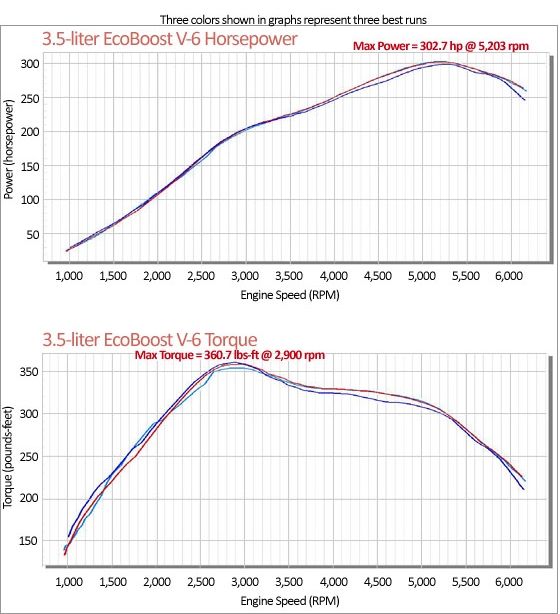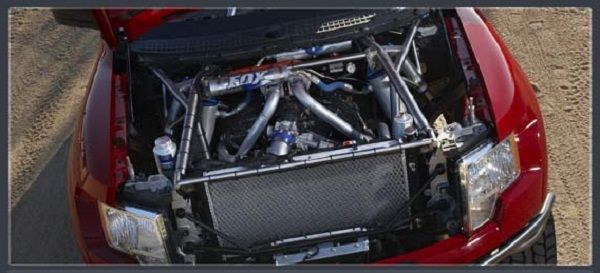The automotive world is full of trends and copycatting, so it is not uncommon to see drivetrain modifications start off small and explode as the years progress. If you think back, you will find one of the slower growing trends in automotive history was fuel injection, as it dates way back to 1925, then by 1940 it was first made electronic by Alfa Romeo->ke1386 engineers. In 1952, it became commercially available via Bosch, but only a few automakers made use of it. By the early-1990s, all but a handful of cars had electronic fuel injection of some sort.
On the opposite end of the spectrum, in terms of rate of growth, is the elimination of V-8 engines in favor of more practical turbocharged V-6 engines. The Ford F-150->ke423 has been on the front lines of this V-8 abandonment front and it all began with the elimination of all but two V-8 engines in 2011 – the 5.0-liter V-8 and 6.2-liter V-8 were the only 8-cylinder engines available – and replacing them with a series of V-6 engines, including: a high-output non-turbo, a 302-horsepower 3.5-liter, a 302-horsepower 3.7-liter, and a 365-horsepower twin-turbocharged 3.5-liter V-6 engine.
Since this successful introduction of forced-induction V-6 engines by Ford, seemingly every company is working on a hot turbocharged V-6 to replace their V-8 engines. The most notable is General Motor’s work on a 3.0-liter turbocharged V-6 for its upcoming Escalade->ke245 redesign and the new Silverado and Sierra. There are also whispers of a twin-turbo V-6 for the Camaro->ke248. Dodge has fallen behind, but has turned its focus more toward making its existing V-8 powered trucks more economical, but will eventually have to switch to turbo power to keep pace.
So the question on everyone’s mind is how do these turbo charged V-6s stack up to the aging and fuel-hungry V-8s?
Click past the jump to read our comparison between the two options.
Why the Switch?
The first thing we have to look at is why in the world would automakers start dropping popular V-8 engines in favor of better tuned and turbocharged V-6s?
The first reasoning is retaining its customer base. As gas prices continue to climb, fewer buyers can continue fueling these V-8 monsters. Another consideration is CAFÉ, which stands for Corporate Average Fuel Economy. These are a series of laws that are requiring automakers to reach certain average fuel economy throughout their entire line up as time progresses. By 2025, automakers are expected to reach 61 mpg CAFÉ and a minimum of 43 mpg on small cars, 46 mpg CAFÉ and a minimum of 34 mpg on all mid-size and full-size cars, 50 mpg CAFÉ and 37 mpg minimum on all small SUVs and pickups, and 30 mpg CAFÉ and 23 mpg minimum on all full-size pickups and SUVs.
Below is the yearly graph for CAFÉ standards on each segment through 2025:
Compact Passenger Cars (42 sq. ft. footprint and smaller)
|
Year |
CAFÉ |
EPA Rating |
|
2012 |
36 mpg |
27 mpg |
|
2013 |
37 mpg |
28 mpg |
|
2014 |
38 mpg |
28 mpg |
|
2015 |
39 mpg |
29 mpg |
|
2016 |
41 mpg |
31 mpg |
|
2017 |
44 mpg |
33 mpg |
|
2018 |
45 mpg |
34 mpg |
|
2019 |
47 mpg |
35 mpg |
|
2020 |
49 mpg |
36 mpg |
|
2021 |
51 mpg |
37 mpg |
|
2022 |
53 mpg |
38 mpg |
|
2023 |
56 mpg |
40 mpg |
|
2024 |
58 mpg |
41 mpg |
|
2025 |
61 mpg |
43 mpg |
Mid- and Full-Size Passenger Cars (55 sq. ft. footprint and larger)
|
Year |
CAFÉ |
EPA Rating |
|
2012 |
28 mpg |
21 mpg |
|
2013 |
28.5 mpg |
22 mpg |
|
2014 |
29 mpg |
22 mpg |
|
2015 |
30 mpg |
23 mpg |
|
2016 |
31 mpg |
24 mpg |
|
2017 |
33 mpg |
25 mpg |
|
2018 |
34 mpg |
26 mpg |
|
2019 |
35 mpg |
26 mpg |
|
2020 |
36 mpg |
27 mpg |
|
2021 |
38 mpg |
28 mpg |
|
2022 |
40 mpg |
30 mpg |
|
2023 |
42 mpg |
31 mpg |
|
2024 |
44 mpg |
33 mpg |
|
2025 |
46 mpg |
34 mpg |
Compact Pickups and SUVs (41 sq. ft. footprint and smaller)
|
Year |
CAFÉ |
EPA Rating |
|
2012 |
30 mpg |
23 mpg |
|
2013 |
31 mpg |
24 mpg |
|
2014 |
32 mpg |
24 mpg |
|
2015 |
33 mpg |
25 mpg |
|
2016 |
34 mpg |
26 mpg |
|
2017 |
36 mpg |
27 mpg |
|
2018 |
37 mpg |
28 mpg |
|
2019 |
38 mpg |
28 mpg |
|
2020 |
39 mpg |
29 mpg |
|
2021 |
42 mpg |
31 mpg |
|
2022 |
44 mpg |
33 mpg |
|
2023 |
46 mpg |
34 mpg |
|
2024 |
48 mpg |
36 mpg |
|
2025 |
50 mpg |
37 mpg |
Mid- and Full-Size Pickups and SUVs (75 sq. ft. footprint and larger)
|
Year |
CAFÉ |
EPA Rating |
|
2012 |
22 |
17 |
|
2013 |
22.5 |
17 |
|
2014 |
23 |
18 |
|
2015 |
23.5 |
18 |
|
2016 |
24.5 |
19 |
|
2017 |
25 |
19 |
|
2018 |
25 |
19 |
|
2019 |
25 |
19 |
|
2020 |
25 |
19 |
|
2021 |
25 |
19 |
|
2022 |
26 |
20 |
|
2023 |
27 |
21 |
|
2024 |
28.5 |
22 |
|
2025 |
30 |
23 |
This perception of a V-6 getting significantly better mpg than a V-8 is ultimately the driving force behind it. We will get into whether this perception is true or not next.
Fuel Economy
The true test of the validity of these turbocharged V-6 engines is to put their key benefit to the ultimate test. Are these V-6 turbocharged engines really much more economical than the V-8 engines they replaced?
A great example that shows the benefit of the twin-turbo V-6 engine is the 2012 F-150->ke423 vs. the 2010 F-150->ke423. We’ll use the FX4 SuperCab 6.5-foot bed on both, just so we are comparing an apple to an apple. In 2010, this F-150 came with a 5.4-liter V-8 engine that got a respectable 14 mpg in the city and 18 mpg on the highway, just barely meeting the minimum EPA rating that began in 2012. The V-6 that replaces this 5.4-liter in the same trim level on the 2012 model is a 3.5-liter twin-turbo V-6 that gets 15 mpg in the city and 21 mpg on the highway. Yeah, that’s not much of an increase, but it gives it a little cushion between its rating and the minimum requirements.
Unlike naturally aspirated engines, the EPA does not really test these turbocharged engines in real-life scenarios. The thing with a turbocharged engine is that is has a very sharp powerband and some people can’t keep their foot out of it. Fortunately for Ford, the twin Garrett GT15 turbochargers bolt up to an already-powerful and torque-heavy 3.5-liter V-6, so it hits its peak torque early on and prevents the driver from gunning the throttle to overcome turbo lag – the amount of time it takes for the turbo to spool up to speed.
So we definitely do see an increase in mpg and we are just starting to scratch the surface of using turbochargers to increase fuel economy.
Horsepower
Many old-timers hear “six-cylinder” and immediately peg it as a sub-200-horsepower dog, a la the 4.3-liter Vortec from GM->ke1024. First of all, those days are over, as V-6 engines are now regularly well over 250 horsepower, thanks to advancements by Chrysler->ke21 in the late-1990s and everyone mimicking them. Some even crest the 300-horsepower mark, like the 300+ horsepower 3.7-liter V-6 found in the F-150, Mustang->ke428, and Explorer PPV->ke342, or the 323-horsepower 3.6-liter V-6 in the base Camaro->ke248. Even Dodge->ke28 has gotten in on the fun with its 300+ horsepower Pentastar V-6 engine.
With all of that power coming from naturally aspirated V-6 engines, you can see that the options are nearly limitless when you start adding in some boost. Going back to the Ford F-150 FX4 SuperCab 6.5-foot bed, you can see that the 2010 model year’s 5.4-liter V-8 engine walloped some concrete with 310 horsepower at 5,000 rpm and 365 pound-feet of torque at 3,500 rpm. That’s not bad at all.
Let’s fast-forward now to 2012 and have a look at the same trim level with the twin-turbocharged 3.5-liter V-6 engine. This nasty machine cranks out 365 horsepower at 5,000 rpm and 420 pound-feet of torque at 2,500 rpm. That’s 55 more ponies and 65 more pounds of twisting from two less cylinders and two turbochargers.
What’s even more impressive is that Ford->ke31 managed to tune the twin Garrett turbochargers to allow maximum torque at a diesel-like 2,500 rpm and keep the peak horsepower at the same rpm as the 2010 model year. While the engineers at Ford managed to give the EcoBoost a nice smooth torque and horsepower curve, some other companies may sacrifice smoothness for peak power, which kills the drivability of a turbocharged vehicle. Granted, it makes it fun as hell with an aggressive curve, but you can’t drive a pickup truck everyday like that.
So ultimately, yes, a turbo charged V-6 engine can produce as much, if not more, horsepower and torque than a naturally aspirated engine. The key is retaining the drivability of the vehicle by keeping the torque and horsepower curves smooth in a turbocharged engine, which requires some serious engineering work.
The Feel and Sound
Okay, we are not going to kid ourselves and claim that a turbo V-6 has any resemblance to the glorious rumble of a V-8. There is just something about a V-8, particularly one with an aggressive camshaft grind, which just makes us feel all warm inside. A turbocharged engine has a great sound, but it is more high pitched and buzzy than a naturally aspirated V-8.
Having said that, there are plenty of exhaust and camshaft kits that you can buy aftermarket to help a V-6 sound more V-8 like, but you can never exactly replicate the sound or feel of that V-8 muscle. In this instance there is really no comparison and we will not even entertain the thought of simulate engine sounds, the BMW M5->ke2922 and the Maserati Kubang->ke334 diesel offer plenty of simulated engine noise to last at least a few generations without ever seeing it again.
So in this instance, the V-8 muscle outweighs the scientific V-6 twin-boost.
Durability
Let’s face it, all modern engines are so high-tech that you need a master’s degree in engineering just to change the oil and reset that damn “Change Oil Soon” message. So to say a turbocharged engine is harder to work on than a modern V-8 is like saying quantum physics is harder to master than particle physics. They are both tough and you never want to have to work with either, unless you are a glutton for punishment. For that reason, you want to make sure you are getting the most reliable engine for your money.
In the past, particularly in the 1980s, when someone heard the term “turbocharger,” dollar signs began appearing as he thought of all of the repair bills from the turbo failing. Well, these are not your 1980s Chrysler->ke21 turbochargers from Lebarons and Lancers->ke1122 that need replaced every 60,000 miles. These modern turbos are extremely advanced and have a thin film of oil around the ball bearings -- the most common items to fail in a turbo -- to keep them lubricated at all times.
Add the advancements in turbocharger technology to the fact that manufacturers do not have factory-installed turbochargers tuned to their maximum output, and you have far more reliable turbo engines than we have ever seen before. The verdict is still pending on the real-life reliability of these new turbo V-6 engines, but on paper they appear just as reliable as naturally aspirated V-8 engines. Plus, these V-6 engines do not require complex fuel conservation systems, like Chrysler’s Multi-Displacement system, which are bound to catastrophically fail one day, giving Chrysler technicians around the world major headaches.
Final Decision
As of now, we have to say that turbocharged V-6 is a drastically better option than a V-8 and will eventually replace the 8-cylinders altogether. These turbo engines are just as reliable, have the same or more horsepower than a V-8, get 10 to 20 percent better fuel economy, and are becoming cheaper to build every day.
We assume that few V-8s will exist, except in supercars, around 2018. There is no reason to keep them around and with the turbo generation – those born in the 1980s – getting older, the turbocharger will become the most popular option for performance gains.





